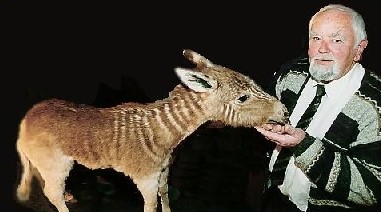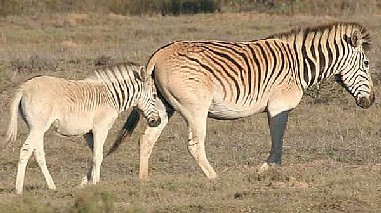Head of Quagga Project Dies
Posted by: Loren Coleman on March 23rd, 2006
The founder of the Quagga Project, South African taxidermist Reinhold E. Rau has died.
Rau, who spent thirty years attempting to breed back into existence the quagga, an extinct zebra and nearly achieved it, died last month at his home in South Africa. Rau was born on February 7, 1932, and died on 12 February 12, 2006.

Reinhold E. Rau at the South African Museum, a natural history museum in Cape Town, with the stuffed quagga foal that became the focus of his project.
As Bernard Heuvelmans mentioned in his famed checklist of 1986, there continue to be reported sightings of Quagga in the wild during the 20th century, from the area of Namibia (formerly South West Africa). Rau wanted to bring them back, because the general wisdom is that they are extinct.
Quoting a selection from the obituary in The New York Times, Donald G. McNeil, Jr. writes:
Mr. Rau’s interest was the quagga, an equine beast of the arid southern Africa grasslands that was hunted to extinction in the wild in the 19th century. The last known one in captivity died in the Amsterdam Zoo in 1883.

An old photograph of one of the last quaggas in captivity, this one a mare at the London Zoo.
Quaggas were shaped like plains zebras but usually had only a few stripes on the head and neck, brown bodies and whitish hindquarters. The early Dutch settlers used to joke that the quagga was a zebra that had forgotten its pajama bottoms, and they named the beast for the sound of its alarm call, which is pronounced KWAH-ha, with a guttural "ch" connecting the two syllables.
But because it competed with livestock for grass, ranchers shot it as a pest. Its disappearance from the wild, presumably in the 1870’s, was so little noticed that the Cape Town colony passed legislation to protect it only in 1886, after it was extinct.
Mr. Rau, who grew up near Frankfurt, immigrated to South Africa in 1959 to take a taxidermy post at the museum. Among the museum’s specimens, he found a stuffed quagga foal, which he said in his unpublished memoirs was "crudely stuffed in 1859 and appeared in a sad state."
In his youth, he had seen German zoo directors try to recreate an extinct ox called the aurochs by crossbreeding existing oxen with the size and coloring of the aurochs. He conceived an idea of doing the same for the quagga — but that would be scientifically feasible only if the quagga was, as he suspected, not really the separate species that taxonomists considered it, Equus quagga, but a subspecies of the plains zebra, Equus burchelli, which had lost its stripes to better blend into the treeless Karoo semidesert of southern Africa.
In 1969, while remounting the museum’s quagga, he made a crucial discovery: he found that the skin had not been tanned and had been badly cleaned. He scraped out and saved some blood vessels, muscle and tissue that still clung to it. It was not until 1981, however, that genetic science advanced enough to let him share the tissues with scientists from the San Diego Zoo and the University of California. In 1985, they confirmed that the quagga’s mitochondrial DNA was essentially identical to that of the zebra.
Initially, Mr. Rau found little support for his ambitious project to find zebras with brownish stripes and crossbreed them with zebras with very pale rumps, even though he had seen the former in herds in Namibia’s Etosha Park, and the latter in eastern South Africa. Finally, the use of a farm was offered by the Cape Department of Nature Conservation, and Mr. Rau’s museum, the University of Cape Town and the South African Nature Foundation contributed money to help capture wild zebras.
The project began in 1987 and grew, and as the years passed, Mr. Rau began keeping small herds anywhere he could find fences that could hold them, grass that would feed them and landowners willing to accommodate them. Besides using private game reserves, he kept some animals in his project on the grounds of the national particle accelerator and of an explosives factory.
By last summer, he said he thought he was nearing success: a stallion and three mares on a private reserve belonging to a plastics manufacturer had produced a foal named Henry who had a striped head, but a pelt that was a soft yellowish-brown from his ribcage to his buttocks.
Gazing at it through binoculars, Mr. Rau, according to [writer D. T.] Max, had said with satisfaction: "Look at those stripes. They go nowhere near the belly. That’s very quagga."

That’s "Henry" to the left.
Appreciation to Princeton’s Richard D. Smith for alerting Cryptomundo to this sad news.
—
About Loren Coleman
Loren Coleman is one of the world’s leading cryptozoologists, some say “the” leading living cryptozoologist. Certainly, he is acknowledged as the current living American researcher and writer who has most popularized cryptozoology in the late 20th and early 21st centuries.
Starting his fieldwork and investigations in 1960, after traveling and trekking extensively in pursuit of cryptozoological mysteries, Coleman began writing to share his experiences in 1969. An honorary member of Ivan T. Sanderson’s Society for the Investigation of the Unexplained in the 1970s, Coleman has been bestowed with similar honorary memberships of the North Idaho College Cryptozoology Club in 1983, and in subsequent years, that of the British Columbia Scientific Cryptozoology Club, CryptoSafari International, and other international organizations. He was also a Life Member and Benefactor of the International Society of Cryptozoology (now-defunct).
Loren Coleman’s daily blog, as a member of the Cryptomundo Team, served as an ongoing avenue of communication for the ever-growing body of cryptozoo news from 2005 through 2013. He returned as an infrequent contributor beginning Halloween week of 2015.
Coleman is the founder in 2003, and current director of the International Cryptozoology Museum in Portland, Maine.










wow. what a great story. hats off to Mr Rau! (not least for his vision, determination and care)